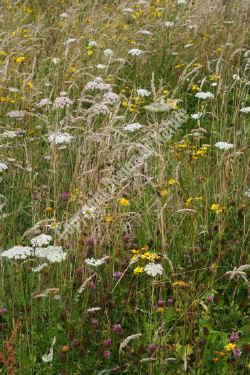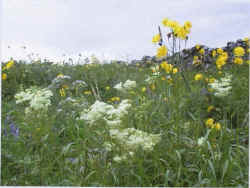| If purchasing this
seed mix, save or print this page and keep it as your reference.
Native Origin Irish Wildflower Seed Mixture: Range: Meadow Mixtures (Code MM) Supplied without grass, Grass seed can be added Product Name: MM01 - Wild Flora for Fertile Top Soil (new top soil) Product Code: MM01 Description: This very colourful seed mixture can compete with the vigorous grasses, because all the species in this mixture are tall and or vigorous and they will out grow the grass and can be left un-cut until the end of summer. You will have to make a judgment as to when to cut, do not cut so late that it starts to 'lodge' or fall over. Mixture Specifications: This photograph is one day in the life of an ever changing meadow. Species
List: Foxglove is added as an extra, although it likes acid soil.. Product Warning: DBN recommends that this mixture is not for human or animal consumption.
Sowing Specification:
Sowing Conditions:
Normal, roll or rake into surface to
keep out of reach from birds. Can be
Hydrasown.
Seed Sowing Rates:
1.5 grams per metre.
Grass seed or nurse crop requirement: Nurse
Crop: No nurse crop is required. If sown without
grass seed,
this mixture:
Will not require a nurse crop. Performance: Provided the sward is
kept open and a 'Thatch'
is not allowed develop, species will continue to germinate and emerge,
through to the third year. First Year: This mixture contains annuals, they will flower profusely, provided they are sown before June.
They require one cut when finished flowering. Cut once in late August. Cut again in July, August or September, depending on when flower finish or the level of weeds that emerge.
In the third year, If the native grass seeds present in your soil germinate and grow, the meadow will require two or three cuts, the first cut in Spring (April/May) and the second cut in July or August, the meadow can again be cut in September if the grasses are still growing strong. When should this meadow be established and require one cut? A wildflower meadow should last many years, provided the wildflower species were correctly established, weeds were controlled and the meadow was cut and the cut material removed and occasional 'Gaps' are created. If not contact DBN.
Persistence if unmanaged:
Low Disposal of cut materials: Always remove the cuttings, wildflower meadow hay should be removed as soon as possible and not be heaped on site as it will grow mould (a health risk). Meadow cuttings can be spread as compost in sheet mulches around trees and shrubs or composted. Management: Control grasses and weeds until well established. Accept any weeds in first year as they provide cover, once the sward is established, digging, spot spraying or weed wiping can be used to eliminate problem species. Control weeds, especially Creeping Buttercup, if Creeping Buttercup is present cut this meadow in May in year two. The third year is the critical year to maintain this meadow as scutch grass, creeping thistle, nettle and dock will try to dominate as the growing conditions are ideal for such unwanted species.
Most species in this mixture
are 'Browse' resistant. A
General Description of Meadow Range:
Your purchase:
Contributes to DBN's work of creating crops
of Conservation Grade - Native Origin Wild flora. You help us to inform
and pay land-owners to manage native species and to assist DBN in
handing on our heritage for another generation.
|

